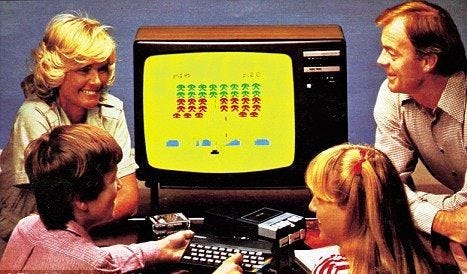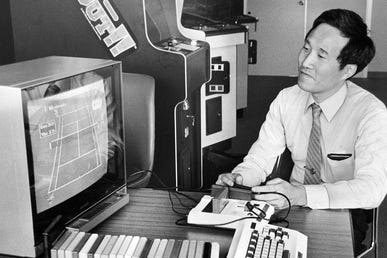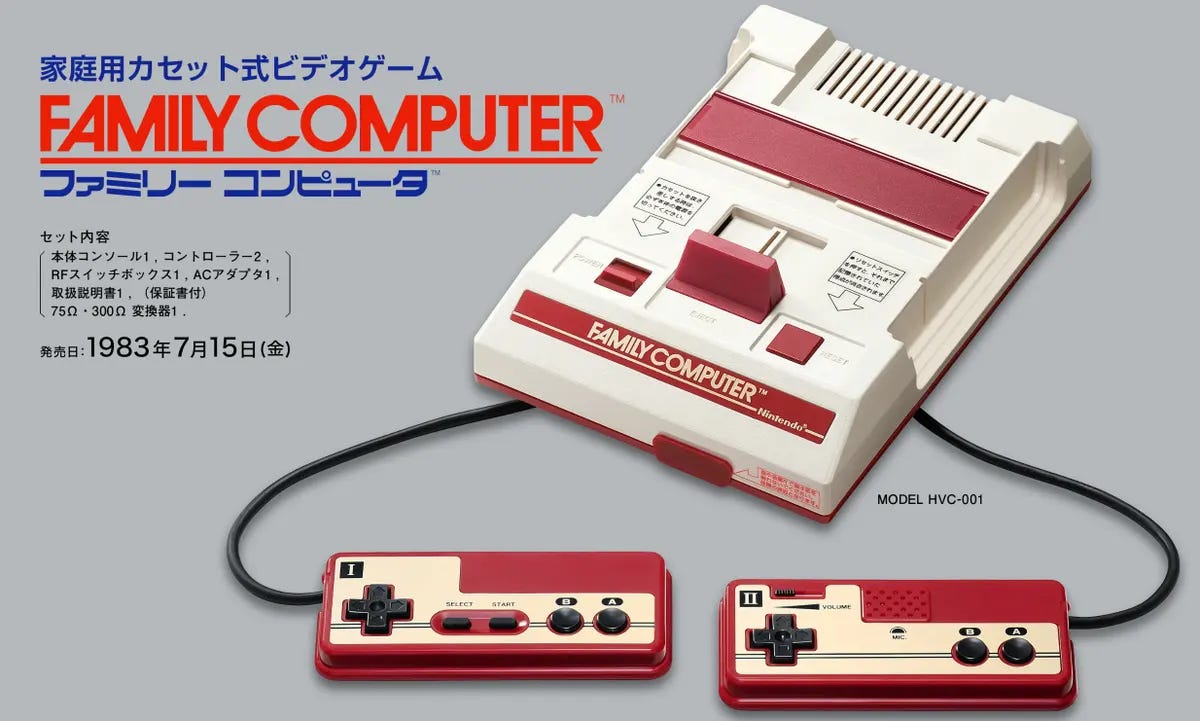Catch Up on the Series
3 - Have You Played Atari Today?
4 - The Great Video Game Crash of 1983
The End of the Atari Age
Atari became the first major platform for video games. However, the North American video game crash in 1983 changed everything. The mystique of the Atari brand was gone, and the video game industry seemed to have been nothing more than an early eighties fad. The combination of a deep economic recession, oversaturation of bad games, and the E.T. debacle led to disinterest from Americans as the console industry plummeted in the country. Atari’s competitors didn’t pick up the slack and had their own issues to deal with. It seemed that video games, at least in the United States, were indeed a fad. However, in the rest of the world, things were different.
Gaming was starting to take off in Europe largely because of the rise of early computer gaming. Devices like the Commodore 64, ZX Spectrum, and even the Apple II were delivering unique independent titles that would set the tone for Western gaming. In Japan, everything was about to change. Nintendo had decided to enter the hardware market. It would go on to release the Family Computer System, unknowingly sowing the seeds for one of the industry’s most consequential games, hardware, and era in gaming.
Computer Gaming
Today, PC Gaming is known for its reliance on download client services such as Steam and the Epic Games Store. But back in the 1980s, things were different. The 1980s was an interesting time for computers. They had yet to penetrate the mainstream market, but you could see what was about to come. Computer companies quickly realized that video games could be a way to convince consumers to buy their machines and eventually expand beyond games. Because of this, some began to market the games on their computers aggressively, and that led to a bunch of developers becoming interested in making games for home computers. This led to new experiments from companies who weren’t tied to competing against the Pac-Man and Space Invaders of the console industry. The console industry was also becoming increasingly Eastern-focused, opening computers to help grow the early days of Western gaming.
One of these computers was the ZX Spectrum, created by Clive Sinclair. Sinclair was an English inventor who would become known as an eccentric and important pioneer in the tech industry of the United Kingdom. The Spectrum would be what the NES was to many American children when it came to many in the UK. Despite being a computer, it was able to gather a catalog of titles as if it were a game console of its own. Classic computer titles like Sabre Wulf, Elite, Knight Lore, The Hobbit, and more made their names known on the Spectrum. A strong community developed around it, with its fans nicknaming it Speccy. European gaming began to rise with the ZX Spectrum.
The Commodore 64 was another home computer that gave way to a successful fanbase and catalog of influential titles. Computer hobbyists fell in love with the Commodore 64, and the demoscene subculture is credited to it. Data showed somewhere between sixty to seventy percent of software sold for the C64 were video games. Commodore leaned into it, and the computer, like Spectrum, almost acted as a dedicated home video game console to many of its buyers. It was even able to remain competitive against the NES and Sega Master System. Western Gaming really cut its teeth on the C64, including Activision. Independent gaming also got its start in Commodore 64, as many of its users began to make their own titles.
There were other popular home computers of the era that made many titles available to its library. With Atari’s downfall, these computers helped early hardcore gamers have something to hang on to outside of arcade cabinets. Some of these would stay strong against the 8-bit systems, as mentioned with Commodore 64. The MSX computers in Japan were filled with many NES ports and were just as much competition to Sega and Nintendo as others of the time. But as great as the early days of computer gaming were, console gaming is still the most mainstream and widespread way people play games. With Atari and the US market collapsing, it was the company that had made Donkey Kong that would not only rescue it but set the precedents for the industry that are still followed to this day.
Project GAMECOM
Following their success with Miyamoto’s Donkey Kong, Nintendo decided to make their own hardware. President Yamauchi assigned Masayuki Uemura to lead the project and wanted him to target some tough goals. He wanted the new system to be more powerful of the competition by at least its launch time, and he wanted the system to be priced competitively to penetrate a mass market in Japan. The code name for the project was GAMECOM.
In 1981, Epoch’s Cassette Vision launched and quickly became a hit in Japan. Yamauchi instructed his R&D team to make their new system stronger and less expensive than the Cassette Vision. They looked at all the competitors of the day and concluded they could produce a more powerful system at the right price. The team decided that the integrated circuit boards that powered the Donkey Kong cabinets would be the technology to power the new console. Coleco’s ColecoVision was actually used as a blueprint by Nintendo, as, at the time, they were doing business with them.
They held a meeting with semiconductor Ricoh, the same company that helped with the Nintendo Color TV systems and handed them a Donkey Kong arcade cabinet to examine. The goal was to make a system that could play Donkey Kong in its full arcade graphic glory. The final specifications produced an 8-bit MOS Technology 6502 CPU, a custom graphic chip by Ricoh, and they added a 15-pin expansion port to add future peripherals. This expansion port would be used for the later-released Famicom Disk System. Nintendo unveiled its new console at a company exhibition event and called it the Family Computer. In July 1983, the Family Computer (or Famicom as it's been nicknamed) was launched.
The Family Computer was purposely designed to look like a toy. It had red bars added to its mostly white casing. A cartridge slot was put on top, and the controllers would reuse the Game N’ Watch’s revolutionary D-Pad, a controller feature that not only continues to this day but is widely seen as one of Nintendo’s greatest contributions to gaming. To finish the design off, Nintendo attached the controllers to the system and added a lever to help get cartridges out, with the idea being kids would love to use the lever similar to a toy. One of the most consequential game platforms of all time was here.
Collecting Coins
Nintendo’s Family Computer was launched at a price of what today would be about $450. At the time, it was a lower price than most gaming consoles on the market. Japan followed the war by becoming an economic powerhouse, specifically in the electronics side of things. The Japanese middle class was ready and hungry for video games much more than their Western counterparts. Donkey Kong was the biggest launch title for the system.
Nintendo had plans to release the Famicom in North America through Atari. The plan was for Atari to make the Nintendo Enhanced Video System and get it out by the 1983 holiday season. After some brief confusion regarding Donkey Kong rights, Atari and Nintendo’s partnership began to fall apart. The North American video game crash did nothing to help matters. With that, an international release would have to wait.
Nintendo looked elsewhere for American profits, specifically the arcades. Arcades were not hit as hard in 1983 as the console industry. So, they created the Nintendo VS arcade cabinet, which was made with Famicom technology. The machine was an instant success and became Nintendo’s profit maker for the North American division. They were able to port some Famicom titles to the machine, which kept Nintendo’s name alive to American consumers. Yamuchi felt that the North American video game market wasn’t dead yet, and he believed Nintendo could launch a successful game console to the market. So their next big project would begin: get the Famicom in Americans’ hands.
Leaving Luck to Heaven
The video game market crash had given way to a sort of refresh in the industry. Computer gaming had started to gain an audience and following, Nintendo had realized they could make hardware, and the North American market was slowly coming back. This would become a formula for a perfect storm for the next major era in the industry. Nintendo was about to change the idea of what a game console was and introduce some of the most iconic games and characters in gaming. Meanwhile, their first major competitor was setting the stage for the first “console war” in video games, and Donkey Kong’s Jump Man was going to become a household name.





